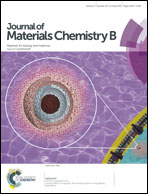A direct cell printing supplemented with low-temperature processing method for obtaining highly porous three-dimensional cell-laden scaffolds
Abstract
A simple and versatile cell dispensing method for fabricating three-dimensional (3D) cell-laden alginate scaffolds using a low-temperature biofabrication process is proposed. To obtain optimum processing conditions, various low temperatures from −2 °C to −40 °C were used. Taking the pore structure (strut size, pore size and pore connectivity) and in situ cell viability into consideration, –10 °C was found to be the most appropriate processing temperature. In addition, the rapid temperature change during processing was a critically important parameter affecting initial cell viability. To examine this effect, we used various cell stabilization times during low-temperature processing. Inclusion of a stabilization time of over 60 min significantly improved cell viability compared to times below 30 min. Based on these optimized conditions (−10 °C and 60 min), we successfully fabricated various precisely controlled 3D cell-laden pore structures, and the in situ cell viabilities for osteoblast-like cell (MG63) and mesenchymal stem cell (MSC)-laden scaffolds were 84% and 70%, respectively. During long cell culture periods (20, 45 and 60 days), the cells in the alginate scaffolds survived, proliferated and even mineralized well. These results suggest that this new biofabrication process has great potential as a method for obtaining cell-laden scaffolds.


 Please wait while we load your content...
Please wait while we load your content...